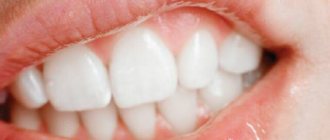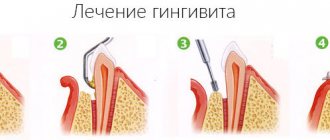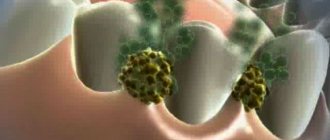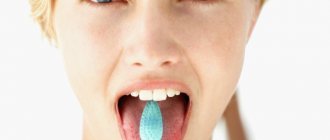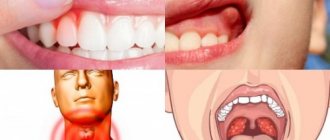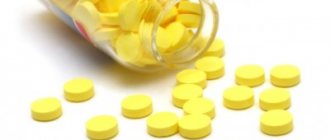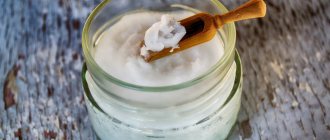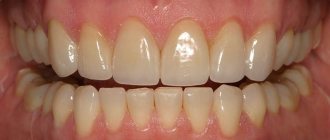Periodontal disease refers to rare but very serious diseases of the periodontium – the tissues surrounding the tooth. It is characterized by irreversible dystrophic changes that gradually lead to complete loss of teeth. And although this pathology affects only 5-7% of people, the problem of its treatment is always quite acute.
Therapy for this disease includes various methods: sanitation of the oral cavity, mechanical cleaning, physiotherapy, as well as treatment of periodontal disease with drugs. Let's look at the most effective of them.
Periodontal tissue disorders can be hereditary.
Symptoms
Please note that periodontal disease is a very rare disease. It mainly affects older people.
The disease occurs unnoticed. Often patients are unaware of its presence. The disease is discovered by the dentist during examination. But the symptoms of periodontal disease are similar to other diseases.
The patient often complains of:
- Bleeding gums.
- Unpleasant smell.
- Taste of blood.
- Swelling of soft tissues.
- Reaction to irritating factors (hot, cold, sour).
- Sore gums.
- Discharge of pus.
- Mobility of teeth.
Only a doctor can correctly determine that a patient has periodontal disease.
Basically, the patient comes to the dentist to remove tartar. Professional cleaning helps reveal a deplorable picture: the patient has periodontal disease of a certain stage.
To paint a clear picture of the disease, we will analyze the stages, characteristics and symptoms of periodontal disease.
Stages
- Initial stage Characteristics: the inflammatory process has begun. Symptoms: no symptoms.
- First stage Characteristics: slight receding gums, teeth in their sockets stand firmly, changes in bone tissue are visible on x-rays. Symptoms: slight tooth sensitivity appears (not a common occurrence).
- Second stage Characteristics: the necks of the teeth are exposed; interdental gaps appear; the transition of the tooth enamel at the root into a solid substance is visually noticeable; X-ray shows that the alveolar process is greatly changed. Symptoms: severe sensitivity of teeth.
- Third stage Characteristics: the roots of the teeth at the edge of the gums have protruded more than half; the gaps between the itches are greatly expanded; teeth are very mobile; X-ray shows a decrease in the alveolar area by a centimeter. Symptoms: painful sensations when eating cold, hot and sour foods.
- Fourth stage Characteristics: the roots are visible at 2/3 of their length, x-ray shows that they are held in place only by the tip. Symptoms: severe mobility that interferes with conversation and eating.
Symptoms of periodontitis
Signs of the disease depend on the location of the inflammatory process and the degree of neglect of periodontitis. The patient is expected:
increased sensitivity of enamel;- bleeding gums when brushing teeth;
- unpleasant purulent odor from the mouth;
- gaps between teeth in the pocket area;
- pain when brushing or chewing;
- exposure of the tooth root;
- increased saliva viscosity;
- slight inflammation of the lymph nodes under the jaw.
The root part of the enamel darkens, yellow or brownish dense plaque appears. After the inflammatory process occurs, the problem area of the gums becomes dark red. Signs of periodontitis intensify as the disease progresses.
Photo: signs of periodontitis
The inflammatory process affects the general condition of the body. Signs of mild intoxication appear: weakness, headache and dizziness, possibly a slight increase in temperature. Coupled with inflammation of the submandibular lymph nodes, periodontitis can be mistaken for ARVI, so diagnosis is necessary.
Causes
It is impossible to determine 100% the cause of periodontal disease. The only thing that definitely emerges is that it always appears against the background of metabolic disorders in the body. These processes, in turn, proceed incorrectly in many other diseases. Observations of dentists have shown that the following diseases and pathologies usually go along with periodontal disease:
- Endocrine imbalance related to hormones.
- Stomach and intestinal diseases.
- Lack of minerals and vitamins.
- Alcoholism and smoking.
- Diseases related to neurology.
- Malocclusion.
- Diseases of internal organs.
- Improper metabolic processes in the oral cavity.
- Soft tissue injuries resulting from bruises, fractures or due to the installation of orthodontic structures.
- Reduced immunity.
Pathogenic bacteria and dental plaque do not affect the severity of the disease, but aggravate the overall picture.
What is periodontitis
Periodontitis is an inflammatory disease of the periodontium - the tissues surrounding the root of the tooth and holding it in the socket. The periodontium consists of several vessels, canals and nerve fibers that provide protection and nutrition to the tooth.
Photo: periodontal tooth
The pathology develops gradually and in most cases appears against the background of other gum diseases. Usually it all starts with gingivitis - inflammation of the gums. It is provoked by tartar or dense plaque, in which pathogenic bacteria actively multiply. If the inflammatory process is not eliminated in time, harmful microorganisms will spread deeper: into the periodontal tissue.
Inflammation contributes to the opening of periodontal pockets, through which the infection penetrates closer to the root. Bacteria continue to multiply, but stopping the process is more difficult. Gradually, the periodontium becomes loose and lags behind the base of the tooth, causing its mobility.
If treatment for periodontitis is not started in time, it will develop into periodontal disease - atrophy of the periodontal structure that is located around the tooth. The disease begins with damage to the alveolar process, and bone tissue is gradually involved in the process. The result is the loss of healthy teeth.
Stages of disease treatment
It is best to treat periodontal disease within the walls of the clinic. In this case, the treatment steps are as follows:
Medical examination
The treatment involves specialists: dentist, hygienist, periodontist, orthodontist. Each specialist carries out a set of activities in his own area. Usually, out of ignorance, the patient ends up seeing a regular dentist, who subsequently redirects the patient to a periodontist for the next examination, consultation and treatment.
X-ray
If the situation is unclear, the patient is sent for an X-ray. An x-ray will show the degree of tooth destruction and the characteristics of periodontal pockets. After an accurate diagnosis, a treatment plan is drawn up. And if prosthetics are needed, the treatment is coordinated with the orthodontist.
Removing plaque and stone
The gums become inflamed due to deposits and plaque. Treatment of periodontal disease will not be effective unless these deficiencies are removed. Basically, the procedure is performed using a laser by a dentist. In our case, cleaning is carried out by a periodontist.
Drug treatment
Here, vitamins, anti-inflammatory and hormonal drugs are prescribed. Immune stimulating agents are definitely recommended. In addition, doctors can make several injections into the gums, with the help of which the inflammatory process is relieved, the tissue is saturated with oxygen and degenerative changes are eliminated. In the case of acute periodontal disease, the dentist thinks through the sequence of treatment and prescribes a strong antibiotic. During therapeutic treatment, one drug is usually prescribed: lidase, ribonuclease, biogenic stimulants, and others. This disease can be treated topically. To do this, the gums are treated with Chlorhexidine and Cholisal-gel.
Physical treatment
The main goals of this stage are to restore blood supply to the gums, remove hypoxia and saturate soft tissues with oxygen. The following procedures can be used as physiotherapy:
- Laser treatment. The effect quickly removes the inflammatory process, regenerates soft tissue, removes swelling and fights infection.
- Treatment with electrophoresis. The main active ingredient here is calcium gluconate. The procedure helps to completely eliminate dental hyperesthesia.
- Darsonvalization (high-frequency current treatment). This can only be done with a special device. Treatment helps reduce tooth sensitivity, eliminate pain and disperse blood through the vessels. The procedure must be done strictly after removing dental plaque.
- Treatment with ionized air. The treatment involves breathing, with the help of which the capillaries expand and the blood composition is normalized. For complete treatment, 20 procedures of 10 minutes each will be required.
- Vacuum treatment. The essence of the procedure is to influence the affected capillaries. After such treatment, tissue nutrition improves and the atrophy process stops. In addition, the body’s defenses are stimulated.
Treatment of caries and removal of completely destroyed teeth
Treatment of periodontal disease is impossible without sanitation of the oral cavity. Treatment of teeth affected by caries is a very important stage.
Rotten teeth must be removed. They collect a large number of pathogenic microorganisms. And if they are not removed, the gums will constantly be in an inflamed state. Without this, further treatment of periodontal disease makes no sense.
There is one more subtlety: teeth in which the depth of the periodontal pocket is equal to half or more of the length of the tooth root are necessarily amenable to depulpation. Depulpation means removal of the nerve and filling of the canal.
Splinting
The mobility of itching provokes rapid destruction of bone tissue, which consistently leads to an increase in the movement of teeth in their sockets. Thus, a closed process is obtained. In addition, under the influence of chewing load, the teeth diverge in different directions. With such signs, splinting is necessarily indicated. The procedure makes the teeth less mobile, or even stops their movement, inhibits the destruction of bone tissue, and prevents them from moving apart in different directions. The splinting procedure is always indicated before surgery.
Surgical intervention
With moderate and severe periodontal disease, it is difficult to manage without the help of a surgeon. The periodontal pocket reaches 10 mm. Gels, ointments and rinses in this case do not have any effect. Only a surgeon can save the situation. The doctor will restore the affected gum and bone tissue of the alveolar process. To do this, various grafting materials are sutured under the gum. After some time, they take root and lead to the synthesis of bone tissue. With a positive course, the alveolar process grows over time and strengthens loose teeth.
Prosthetics
The procedure is mandatory if one or two teeth are missing. This is especially important for periodontal disease. If there are no missing teeth, but there is a discrepancy, then metal-ceramic bridges will help, which will correct this aesthetic defect.
Professional teeth cleaning
Today, the Vector ultrasonic device is considered an effective installation in this area. This device has a sufficient number of constructive implementations, which together allow a high-quality effect on teeth and gums.
The vector allows you to clean periodontal pockets at a depth of 11 mm or less, of course. The doctor will use different attachments depending on what difficult area needs to be treated. As a result of a well-thought-out design and correct actions, there is no contact with the tissues of the tooth and gums. In problematic cases, you can brush your teeth with the Vector apparatus for a long time, about 2 hours. With slight neglect it will take a little more than 30 minutes.
The Vector cleansing procedure requires repetition. Usually the doctor tells the patient to come back for treatment in 2 weeks. As a result of treatment with the device, the gum tissue is significantly strengthened, the roots are stabilized and dental plaque is not deposited so quickly.
There are no contraindications to the procedure. No pain is felt. In addition, the device can remove almost all deposits. As a result, surgery may not be required.
Treatment methods and popular medications
Only a suitably qualified doctor can recommend the best treatment for periodontal disease in each specific case, based on experience and examination data. There is a certain group of drugs that are actively used for these purposes. To find out more about what antibiotics to take for periodontal disease, you need to consult your doctor. First, you can familiarize yourself with the most popular medications.
In particularly difficult cases, effective treatment of periodontal disease is not limited to taking medications alone. Surgery may be required. During this procedure, the doctor cleanses the sinuses of bacteria and pus that have accumulated there. Such an intervention is often the only way to save teeth when visiting a doctor at the last stage of development.
It is recommended by experts to use a variety of products with local effects. It can be:
- heparin ointment;
- troxevasin gel;
- rinsing solutions based on furatsilin;
- hydrogen peroxide and the like.
Drugs for the drug treatment of periodontal disease are highly effective and low cost. An integrated approach, although it will take more time, can please you with faster results and lasting remission.
Proper treatment of periodontal disease with antibiotics can significantly increase the likelihood of successful recovery from the disease. The most common and effective means include the following:
- metronidazole;
- lincomycin;
- Trichopolum.
Each of these drugs has its own mechanism of action, contraindications and other distinctive properties. It is unacceptable to use medications for periodontal disease without first consulting a doctor . Self-treatment does not guarantee elimination of the disease.
Treatment of periodontal disease at home
The doctor may prescribe medications for the patient to use at home. These can be special gels or ointments. The principle of action of such drugs is simple. Medicines stimulate metabolic processes and make the blood move faster. Soft tissues are saturated with oxygen. As a result, the anti-inflammatory process begins to work.
We list the main medications and their effects:
- Heparin ointment. The product thins the blood and moves it through the vessels faster. Treatment regimen: ointment is applied to inflamed gums in a small amount. Number of times per day: 2. Course of treatment: 14 days.
- Elugel. The drug contains the antiseptic chlorhexidine. Treatment regimen: apply a thin layer to the gums. Number of times: 3-4.
- Solcoseryl. The drug has two methods of use. The product can simply be rubbed in several times a day, or applied to a piece of gauze and placed on the gums. Exposure time: 20 minutes.
- Holisal. Treatment regimen: rub into gums. Number of times: 2. The course of treatment depends on the degree of the disease.
- Homeopathic remedies (phosphorus 6, nitricum acidum 6, iodium 6 and others). Can be used in self-treatment. These drugs are not a panacea. Their intake must be supported by medical medications.
The use of special medicated toothpastes is effective at the initial stage of periodontal disease. This remedy will not be able to cure the patient (even if the packaging says otherwise), but it will remove bad breath and bleeding gums. This paste usually contains natural components of healing herbs.
Symptoms and stages of periodontal disease
It is quite difficult to independently identify periodontal disease at the initial stage - the disease develops asymptomatically, often the patient does not consult a doctor, thereby aggravating the situation. Clinically, the disease becomes noticeable with changes in tissues, with characteristic symptoms:
- the gums become paler, but do not lose their previous density;
- discomfort, slight itching, tingling;
- painful reaction to cold or hot foods;
- thinning of tooth septa, appearance or enlargement of gaps between teeth;
- change in the structure of the tissue around the tooth root.
Important! At the first symptoms of the disease, you must contact a dental clinic to prescribe treatment depending on the stage of the disease - medication, surgery or physiotherapy. You also need to learn how to treat periodontal disease at home.
At each stage of the disease, the patient feels a certain discomfort and anxiety that manifests itself in the oral cavity. Stages of periodontal disease:
- first (initial) - characterized by vague symptoms and a slight decrease in bone tissue - up to 30%, slight itching of the gums, a painful reaction to cold or hot foods and drinks, the teeth are immobile, at this stage you can get by with medication and physiotherapy;
- second (medium) – the symptoms become pronounced, characterized by a decrease in bone tissue by 50%, exposure of the tooth root, gaps between the teeth appear or increase, at this stage drug treatment and surgical intervention are necessary;
- third (late) – characterized by instability, instability and displacement of the dentition, the gums can bleed even with a slight load, the roots of the tooth are exposed, severe pain and sensitivity appear.
Important! Untimely treatment of the late stage of the disease leads to serious complications and tooth loss. In this case, prosthetics will be necessary. If symptoms of the disease appear, you should consult a dentist, also monitor your oral hygiene and learn how to treat periodontal disease at home.
Traditional recipes for periodontal disease
Funds from the people will not be able to cure periodontal disease, but will significantly affect the positive dynamics in treatment.
Rinses
- Using garlic infusion. It is necessary to peel, crush the garlic and pour boiling water over it. Give the product time to brew. Afterwards rinse your mouth 2 times a day. The effect of the treatment will become more noticeable if you keep the solution in your mouth for 5 minutes while rinsing. You can simply rub your gums with a clove of garlic.
- Rinse with sea salt solution. Dosage: teaspoon per glass of warm water. Rinse in several steps for 30 seconds.
- Using calendula infusion. You need to rinse your mouth with the product 7 times a day. To prepare it you need to take 2 tablespoons of the herb, pour 0.5 liters of boiling water and leave for 30 minutes.
- Rinse with kombucha infusion. The product is very rich in vitamin C, which in turn restores blood circulation in soft tissues.
- Rinsing with a decoction of lingonberry leaves. Pour a glass of boiling water over the leaves (a teaspoon), boil, cool and strain. Rinse at least 5 times a day.
- Rinse with water and Kalanchoe juice. Squeeze the juice from the leaves of the plant, dilute it with water and carry out the procedure.
- Using hydrogen peroxide. The drug is drunk, rubbed on the gums and rinsed in the mouth. For internal use: add three drops of the product to 50 ml of water. Drink three times a day. Course: 10 days. Then the treatment can be repeated. The main note: you need to consume peroxide on an empty stomach. For rubbing: moisten a tampon in the product and begin to rub the medicine well into the gums. For rinsing: dissolve two tablets of hydroperite in 100 ml of clean water.
Recipes from nature
- Application of bee products. Propolis and honey help restore blood circulation and relieve irritation. The products have a bactericidal and wound-healing effect. Propolis tincture is used in treatment. Pharmaceutical preparation (10%) in the amount of 25 drops is diluted in a glass of water. Rinse your mouth with this solution after each meal. The tincture in its pure form can be used internally, but only after consultation with a periodontist. From propolis tincture (only 4%) you can make compresses on the sore spot. In addition to propolis, you can rub honey into your gums. Treatment continues until recovery.
- Application of calamus. To do this, calamus is grated, mixed with toothpaste and brushed. The treatment method helps strengthen the gums.
- Application of alum. Mix one teaspoon of alum with ¼ spoon of salt, add a few drops of mustard oil. Directions for use: massage the mixture onto the gums for several minutes.
- Drink cranberry and lemon juice. The products stimulate the immune system, fight bacteria, and have an anti-inflammatory effect. You need to drink 100 ml of any juice every day. If you mix lemon juice with extra salt, you get a medicinal paste that you use to brush your teeth.
- Drink only green tea (avoid black tea). Green leaves heal the entire body, thereby helping it cope with periodontal disease faster.
How to treat with ready-made rinses
For periodontal disease and gum diseases, targeted rinses containing sodium fluoride compounds and chlorhexidine are used. These are medicinal products with the possibility of long-term use. But they have a targeted direction and are considered highly active disinfectants, therefore they require careful use and only with the permission of a doctor.
Forest balm
The drug, composed of medicinal plants (herbs), helps strengthen and improve the condition of the gums, providing them with useful elements. This is an absolutely natural composition (sage, pine nut oil, calendula, nettle, aloe) with a complex effect on the affected areas of the gums.
Apply 2 times a day (morning and evening) after brushing your teeth. The course of treatment is 1-2 months.
Forest balm is considered natural, but the instructions for use and dosage should not be neglected. The series of this product may contain chemical components, fragrances, dyes and preservatives that can lead to side effects.
Lakalut
Popular mouth rinse. Contains sodium fluoride, chlorhexidine. The drug has an antiprotozoal, antimicrobial, astringent effect, eliminates bleeding gums, and strengthens the enamel.
Mexidol Dent
The rinse for periodontal disease contains licorice and Mexidol, an antioxidant to normalize redox processes in tissues and cells. A drug:
- prescribed to patients with removable dentures for prophylactic purposes to prevent the development of inflammation;
- promotes gum regeneration, supplying cells with oxygen, normalizing microcirculation in blood vessels.
You need to rinse for up to 2 minutes with a single dose of 10 ml 3 times a day.
Elmex
Aminofluoride is an active component that provides an anti-inflammatory antibacterial effect. This is the best remedy for periodontal inflammation, treatment of caries and hyperesthesia. The product ennobles the blood vessels located in the oral cavity, the active component forms a film layer on the tooth enamel.
Massage and nutrition
The main effect of massage is to increase lymph flow, speed up healing and increase metabolism. The procedure is done using a vibrating massager or just a finger. The finger must be wrapped in a bandage, which must first be moistened in Vaseline. Next, you need to do vertical stroking actions or perform circular movements. Each jaw should be given 10 minutes. At the same time, we must not forget about the massage of the internal and external sides.
It wouldn't hurt to think about nutrition. That is, to effectively get rid of periodontal disease, you must adhere to a diet. The patient must monitor and control the process of eating food. He shouldn't care what he eats or drinks now. Be sure to remove carbonated drinks, coffee, black tea, cookies, chips and any foods with dyes. We must not forget that sweets cause plaque to form and stimulate the proliferation of bacteria, which over time will lead to tooth decay.
In addition, you need to eat more solid vegetables and fruits. All food must be chewed thoroughly. The diet should include dairy and fermented milk products to strengthen teeth and bones. The above recommendations should be followed for about six months.
The best vitamin and mineral complexes for teeth and gums
Vitamins for strengthening enamel, gums, and preventing bleeding are mainly presented in tablets, less often in effervescent form and in the form of chewable gummies for children. They should be taken in a course without exceeding dosages.
The basis for taking a vitamin complex is a poor, limited diet, the intensive growth phase, pregnancy and breastfeeding, heavy physical activity and sports.
Important! You cannot take several vitamin complexes containing the same components at the same time. Failure to comply with this rule may result in an overdose of substances or hypervitaminosis, increased adverse reactions (diarrhea, abdominal pain, allergic manifestations, etc.).
The frequency of use of medications and supplements is determined by the person's condition, the purpose (adjunct to treatment or prevention), and the agent chosen.
Asept complexes
Under this name of vitamins for teeth and gums, 3 Russian products are produced:
- probiotic complex PARODONTAL;
- Friends probiotic complex for children from 3 years old;
- vitamin and mineral complex.
The first two products strengthen general and local immunity, improve the composition of the bacterial flora of the oral cavity, and prevent the formation of dental plaque and the activity of pathogenic microorganisms. After their use, periodontal diseases, caries, and other processes caused by bacterial, fungal and viral infections are less likely to occur. Asept vitamins are a complement to basic oral hygiene.
They are used in courses for gums for 20–40 days several times a year. These supplements are a source of lactobacilli strains and vitamin D. The tablets must be dissolved until completely dissolved.
Calcium D3 Nycomed
Complex for adults and children in the form of chewable tablets containing cholecalciferol and calcium. It is used to treat conditions associated with a deficiency of these elements, regulate the metabolism of microelements in teeth and other body structures (hair, bones, nails), increase bone density and mineralization of teeth.
Calcium-D3 Nycomed is available in the form of a regular and enhanced formula with the prefix forte. The flavors of the drug are varied: mint, lemon, orange, strawberry-watermelon.
Complivit Calcium D3
Russian analogue of German calcium D3 Nycomed in orange and mint flavor for patients of any age. For very young patients it is available in the form of a suspension. To eliminate the deficiency of elements, the usual formula is used; to treat severe disorders of calcium metabolism, dental density and gum health, a reinforced form with the forte prefix is used.
Bio-Max
Vitamins for treating gums, improving capillary function, stabilizing the condition of teeth and bones, and strengthening the body. Created by a Russian pharmaceutical company for residents of Russia, taking into account the lifestyle of patients, menopausal conditions and nutrition.
The medicine includes 12 vitamins and 8 minerals. A similar action and composition is characteristic of the drug Complivit. It is distinguished by the presence of a sugar-free formula recommended for patients with diabetes.
Solgar Calcium
A quality oyster shell supplement containing a sufficient dose of calcium. It helps strengthen teeth, increase their density, protect bones and teeth from the negative effects of lead.
The advantages of the dietary supplement are convenient use (once a day) and a high dosage for the gums.
Kaltsinova
Chewable tablets for use in children. Contains retinol, ascorbic acid, calcium, vitamins D and B6. The complex composition ensures effective strengthening and protection of teeth and bones in young patients, replenishes the deficiency of these elements during active growth and development, in case of intolerance to the main sources of calcium - milk and products based on it.
Another similar complex for children is Vitamishki Calcium + vitamin D. It is produced in the form of gummy bears.
Askorutin
A cheap medicine for strengthening capillaries and eliminating bleeding from the gums associated with a deficiency of rutin and ascorbic acid. The included components reduce the fragility and permeability of capillaries.
Supplementing ascorbic acid with rutin helps protect the former from oxidation and prevent premature decay, enhancing its effect on the gums.
Alphabet Classic
It consists of useful elements that you can drink when you have gum inflammation. Unlike other multivitamin complexes, the package contains 3 types of multi-colored tablets. Each color contains a specific set of elements for better absorption and is recommended for separate use - morning, afternoon and evening.
Note! If it is inconvenient to take this multivitamin complex three times a day, you can drink 3 tablets of different colors at the same time once a day.
Separation of beneficial micro- and macroelements allows you to reduce negative interactions: according to research, it is undesirable to contain iron and calcium in one tablet, leading to a loss of effectiveness of the second.
Duovit
A complex multivitamin preparation, presented in two-color dragees in the package: minerals are in blue dragees, vitamins are in red dragees. This separation improves the absorption of the medication and reduces unwanted interactions of the elements.
Prevention
From what has been described, it is clear that prevention of periodontal disease is very important, since the disease is difficult to treat. We list the main measures to maintain the health of the body:
- Constantly monitor the condition of internal organs and treat them in a timely manner. After all, serious diseases always go along with periodontal disease.
- Load your body with physical activity. After them, health improves, immunity increases, gums recover faster.
- Carefully monitor dental hygiene. Periodontal health must be protected from a young age. It is necessary to resort to traditional methods of treatment and be constantly monitored by a dentist. Don't forget to brush your teeth regularly. The brush not only performs a hygienic procedure, but also massages the gums well. You also need to clean your teeth. For these purposes, you can use dental floss. Cleaning within the walls of the clinic reliably removes formed tartar.
- Treat caries in a timely manner and monitor your bite.
- Take vitamins. These could be pharmacy complexes or simply healthy eating.
Causes of periodontitis
The main cause of periodontitis is the proliferation of pathogenic bacteria that provoke infection. Various factors can contribute to this pathological process, including:
Gingivitis gumsadvanced gingivitis;
- diseases that weaken the immune system;
- hypertonicity of the jaw muscles;
- damage to the oral mucosa;
- tartar;
- stress and bad habits;
- improper hygiene;
- diseases affecting the acid-base balance in the body;
- genetics.
One of the factors contributing to the occurrence of periodontitis is poor nutrition. Lack of vitamins weakens the immune system, and not eating enough solid food leads to slow bone depletion.
A rare dental examination increases the likelihood of developing advanced periodontitis. Previous gingivitis often occurs without obvious signs, and only a professional can notice the pathological process. A timely visit to the doctor allows you to notice the violation in time and quickly eliminate it.
Periodontitis most often develops in adults; people aged 16 to 30 are at particular risk. Frequent drinking of alcohol or smoking increases the likelihood of rapid development of inflammation in the gums. If the dentist can accurately determine the origin of the pathology, it will be easier to treat it, and the transition to periodontal disease will not occur.
